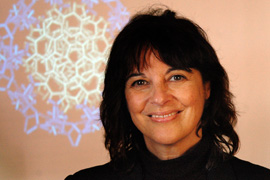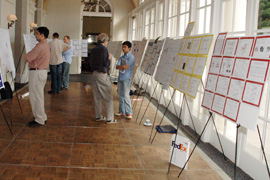Scientists Share Research at Molecular Biophysics Retreat
 |
| Gloster Aaron, assistant professor of biology, speaks on “Neurons looking back before firing: the timing of action potentials” during the Molecular Biophysics Retreat Sept. 21. |
| Posted 10/05/06 |
| Established and budding scientists attended the Seventh Annual Wesleyan University Molecular Biophysics Retreat at the Wadsworth Mansion in Middletown on Sept. 21. The retreat is an annual celebration of the Molecular Biophysics Program, which is co-directed by David Beveridge, professor of chemistry and Ishita Mukerji, associate professor and chair of molecular biology and biochemistry.
Organized this year by Beveridge and Manju Hingorani, associate professor of molecular biology and biochemistry, the event was supported by the Edward W. Snowdon lecture fund, the Molecular Biophysics Program, the departments of Chemistry and Molecular Biology and Biochemistry and the Howard Hughes Medical Institute. The retreat was designed to bring together students and faculty in the molecular biophysics and biological chemistry programs and provide them an opportunity to discuss their current research, explore new ideas and possible collaborative work. About 50 people attended this year’s retreat.
Barton discussed how electrons move through DNA structures and how this process can mediate DNA damage and repair. “By researching what happens inside the cell that leads to DNA mismatch formation and repair, we may better be able to understand how certain types of cancer occur,” Barton says. In a complementary talk titled “Mopping up after messy polymerases,” Professor Hingorani discussed her research on mechanisms of DNA damage and repair, involving proteins linked to carcinogenesis.
Augustyn’s poster detailed how electric charges migrate through DNA, more specifically how cells, like those exposed to UVA radiation, could be damaged by charge migration. She also spoke with students about her research at a Wesleyan Women In Science seminar Sept. 22. Rex Pratt, Wesleyan University professor of chemistry, described his studies about a class of enzymes that catalyzes the last step in bacterial cell wall biosynthesis. “These enzymes are the targets of beta-lactam antibiotics such as penicillin,” says Pratt. “Our aim is to learn more about these enzymes at a molecular level to assist further drug development.” Ryan Pelto, a fourth year chemistry graduate student at Wesleyan, who conducts research with Pratt, presented a poster about bacterial resistance to current ß-lactam antibiotics and how ß-lacatamase enzymes play a major role in bacterial defense mechanisms. Other Wesleyan University scientists presented research, including new faculty member Gloster Aaron, assistant professor of biology, neuroscience and behavior, and T. David Westmoreland, associate professor of chemistry. Aaron’s research investigates how neurons communicate with each other and produce precise patterns of activity. The title of his talk was “Neurons looking back before firing: the timing of action potentials.” “In this ongoing work, we are demonstrating that slow currents in some groups of neurons produce, in a sense, a memory of past communications from other neurons,” says Aaron. “Thus, the decision of when to fire an action potential can incorporate messages from further back in time than had previously been assumed. This research may help us understand how precision is produced in a network that appears at first glance to be composed from imprecise elements.” Westmoreland’s talk was titled “Marcus Theory and Atom Transfer: It’s not just for electrons. “The most important type of atom transfer, both from a biological and an industrial point of view, involves the transfer of a single oxygen atom,” says Westmoreland. Westmoreland’s talk reported on the progress in showing how the conceptual framework previously developed for reactions that involve transferring a single electron can be extended to include single atoms as well. He hopes that this work will provide new insights into the functions of a number of important enzymes and may point to new industrial catalysts. |
| By Laura Perillo, associate director of Media Relations; photos by Olivia Drake, Wesleyan Connection editor |


 Jacqueline Barton, pictured at right, the Arthur and Marian Hanisch Memorial Professor of Chemistry at the California Institute of Technology and member of the National Academy of Sciences, was the keynote speaker.
Jacqueline Barton, pictured at right, the Arthur and Marian Hanisch Memorial Professor of Chemistry at the California Institute of Technology and member of the National Academy of Sciences, was the keynote speaker. The event also featured 26 posters by several Wesleyan students and alumni including, Katherine Augustyn, a fifth year graduate student at the California Institute of Technology and double major in chemistry and molecular biology and biochemistry.
The event also featured 26 posters by several Wesleyan students and alumni including, Katherine Augustyn, a fifth year graduate student at the California Institute of Technology and double major in chemistry and molecular biology and biochemistry.